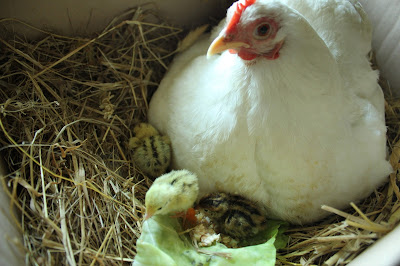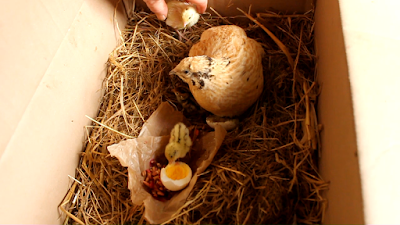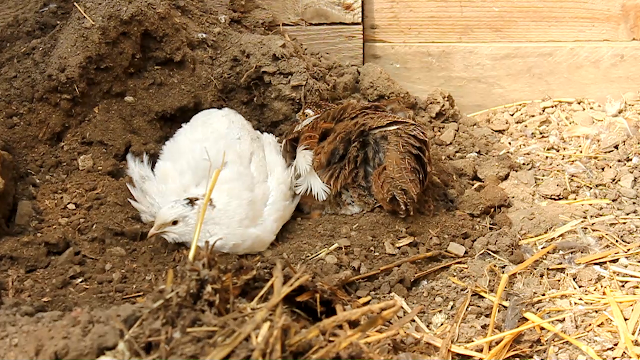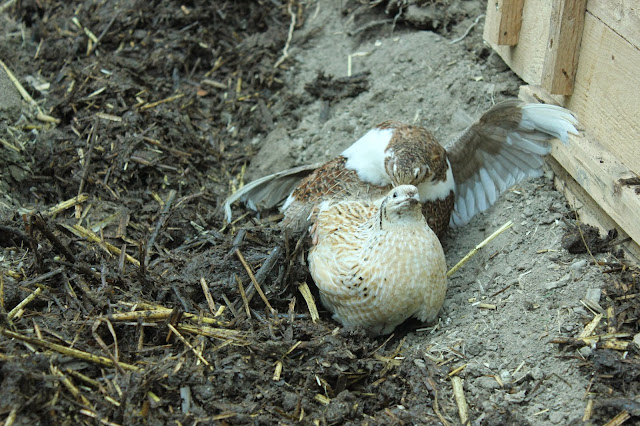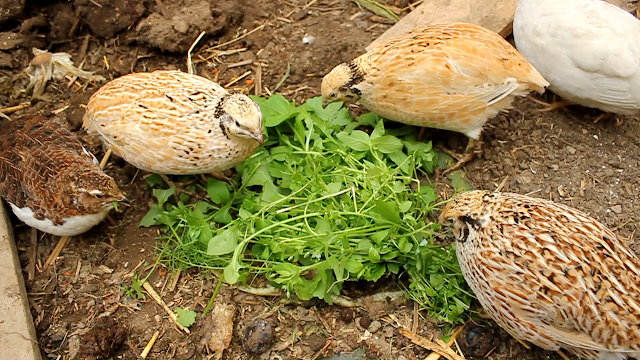Every July for the past four years we have had a stand at a local 'Art in the Garden' exhibition. Each time we have featured one of our larger recycling projects; the composting toilet, the pedal-powered washing machine and this year the 'organic no-electricity, incubator/coop'. Yes you guessed, a recycled untreated pallet wood house and run with a broody hen as the heat source. As an extra twist to the exhibit, the coop was built in situ over the weekend and when it was completed a broody hen, our Cochin 'Snow Kitten', was put inside to sit a few quail eggs. This action brought with it a whole raft of consequences, which have helped me no end in understanding how a broody hen and quail think!
I hadn't really intended that 'Snow Kitten' should raise quail but she was broody and I'm always wanting to spread the word on cage-free quail. In fact it caused quite a stir and even made the local papers. Great but with drawbacks entailed, as our little Cochin although a brilliant mother, witness my recent article on babysitting, is way too fluffy and heavily upholstered and furthermore has those enormous Cochin feathered feet. However, as my male quail had already paired off some months ago and formed a reasonably monogamous bond with Cecily, one of my females, I was in high hopes that, having made a couple of tentative nests and laid a goodly amount of eggs, she would soon become broody. I was further encouraged by the fact that I had even caught her on camera, last year, showing marked interest in Ginger my broody quail's nest. So, I had a back-up plan in case the eggs hatched, this was not a certainty for the following reasons I share below.
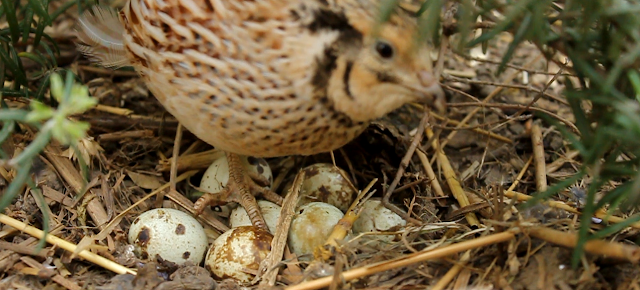 |
| Cecily last year showed more than a passing interest in Ginger's nest |
Monogamous Bonding in Coturnix Quail - Cultivating a Happy Couple
As with last year's hatch, I was well aware that our borrowed male Fred was pro tem bonded to and only interested in our female Ginger. As I had observed that the nest she made and sat on was communal and that she began it only a few days before becoming broody, I was aware that only these last few eggs had a chance of being fertile. When she was a week or so into the sit, she actually began to chase off Fred, who had taken up a position guarding the nest. After this rebuff he then turned his attention to our other quail.
With Algernon, (above) who I bought last year, although initially he was obviously very attached to Cecily, it was not as strong a bond as between Fred and Ginger and in fact, I had seen him with several of the other females. This may be because Cecily although she readily accepted Algernon as a mate, more so actually than Ginger did Fred, she did not become broody after laying a clutch of eggs. I do believe however that the next paragraph will further explain why this happened. My guess is therefore that Algernon has strong breeding instincts and is thus looking for the mother of his chicks! When I collected the eggs to put under Snow Kitten I therefore took a chance that more of them would be fertile. However, if you are planning natural quail keeping, it is as well to be aware that the 'one male for several quail' is not a natural ratio if you are attempting to breed from them, i.e. for the quail to become broody and sit. In my experience, quail seem to be inclined to form pairs and nest, when they have plenty of space in which to do so and are in a quasi wild environment, with a source of wild protein. This was echoed by Orcutt's findings with breeding pairs created at random from quail taken from Cornell University Poultry Science Department and studied in captivity in Ithaca New York (Orcutt and Orcutt, 1976).
How Circumstances Can Work Against Monogamy
Enter now a feral cat, the only curse of living by the sea, where holidaymakers regularly dump or accidentally lose their pets whilst on vacation. This particular subject, large and inquisitive, who like its fellow travellers, had already found food and lodgings in the vicinity, now spent every evening staring in at our quail, as in the past, it had probably watched TV. Against my better judgement, I began to put all our quail together in the coop each night thus, I am certain, endangering the bond between my pair. No longer canoodling on the porch, or rather snuggled down in the lovely leafy bedding of the safe area, my female quail was now forced into communal living overnight. Due to an incident at the beginning of the breeding season where one of my female quail 'Nuggets' had suffered a head injury overnight in the coop, I was now forced to place my male quail in alternative and solitary sleeping quarters.Choosing the Male(s) for your Breeding Pair(s)
When thinking about quail and humans, it is as well to go back to the roots of why man took the quail from the wild and remember that it was to fight and not to lay eggs, nor raise chicks. For this reason many quail keepers find male quail belligerent and overtly harsh with females, thus showing the males to have retained the very characteristics which have been selectively bred and/or fostered in them for centuries. It is therefore of importance to successful pairing, I believe, to select non-aggressive males for your breeding group. These males rather than seeking to fight or philander all the time, will form stable relationships and thus encourage nesting, sitting and hatching. It is also important that your male should be a 'talker'. The male call has been associated with the onset of nest building and indeed I have witnessed this on several occasions and with different groups of quail. I have found that the male does not call over the Winter but only starts to vocalise a few days before we get our first quail egg. Thus male vocalisation is a great indicator for letting you know that everything is going according to plan! I have to say that we have not yet attempted to keep several pairs of bonded quail together, we have only kept one pair within a group of females.
The Day of the Hatch
 |
| Now what have you let me in for? |
The quail hatched on the 17th day of incubation, which was last Wednesday, the 6th of July, under Snow Kitten and she accepted them immediately, even though she had several 'hard stares' at them from time to time as if she was wondering what on earth she had hatched. She had however, accepted the eggs very easily, never giving them a second thought. The chicks in turn responded very well to her. My greatest fear was for the movement of her feet but for the first two days she was incredibly careful, it was as if she had literally sized up the quail and knew she needed to shuffle in those big feathery Cochin slippers. One thing is very certain about quail hatched with hens, they are kept exceedingly warm in those feathers. In observing Ginger last year, I realised why hen-hatched quail burrow down so far towards her body, that they risk strangulation when she gets up in the morning. This is why I am so careful at these times to check a hen over for attached chicks. The answer seems that the quail chicks 'hook' themselves to their mother and she can actually walk with them all on board to a new area. This is during the first days after hatch when they are particularly vulnerable.
The Aftermath of the Hatch
Two days after hatch on the 8th of July, we were obliged to be absent for the greater part of the day and when I returned one of the chicks had been squashed. As I have already written I had been worried about leaving the quail with the hen but she had seemed so careful. However, at day three after hatch, she would have been naturally expecting to leave the nest, even though she still had a couple of non-fertile eggs to keep her sitting. By the evidence she had left the nest and in getting back in had accidentally stepped on one chick. I was therefore in a slight quandary, as Cecily showed no signs of going broody and Algernon had turned his attentions to another of my quail, including Caramel. The latter had created a recognisable nest and on the previous night had just begun to sit on a clutch of eggs. This was a long-shot as Caramel showed no signs of real broodiness, in the way Ginger had and during the whole of the day we observed her leaving the nest for long periods. However, later that evening I observed her back on the nest that she had now carefully embellished with more straw and hay. At the same time I had a protracted hatch going on from a little hen I had found two nights before in the garden. So I planned to put the quail chicks with Caramel and shift an egg from the protracted hatch over to Snow Kitten.
This year, after last year's cornucopia of garden-hatched chicks, I have been very careful to seek out potential promiscuous al fresco nesters and give them one or two eggs each to hatch in a place where I can follow their progress. The above beautiful little hen (Jenny as I now call her, after the Dolly sisters) is a twin, so I had no idea she had gone AWOL until I heard the first chick cheeping! She now has seven chicks plus the two I gave to Snow Kitten.
Problems
Solutions
Over the last couple of days I have observed and learned so much. One item being that temperature is absolutely crucial for quail chicks in the first days of life. Looking at how Caramel now behaves and it has been a massive learning curve for her, she is willing and capable of carrying all the chicks on her body. She is thus keeping them warm on the short journey from one nesting area to the other. She can carry them to the food I have placed within her hay box and I wonder if in the wild she could carry them much further. It would be very interesting to see this, however I have witnessed that she shakes the chicks out of her feathers in the morning and when they have been napping for a long period during the day. It is certain also that she stands up for most of the night and the chicks are either totally burrowed into her feathers and off the ground (the younger ones) or have their feet on the ground but their heads well embedded in her feathers. if I hold a small quail chick and keep his body warm he will make a burrowing motion with his head, even with his eyes closed, as if trying to work his way further in to get nearer to the body of his mother. I noted the temperatures for a quail brooder is marked in several places on the net as 35 to 38 °C (95 to 100°F) for the first week reducing to 32 °C (90°F) in week two. There is no way our house and not even the greenhouse, during the recent terrible weather are achieving that. It is therefore of the greatest importance that Caramel has had to learn and respond to the signals for the chicks being cold.
It has been an enormous burden on our quail to fully understand the intricacies of brooding chicks and so quickly. In a period of only three days she has made the transition from being vaguely broody to full motherhood. By the morning of the 9th, she was already speaking to the chicks and it was a constant call, making sure they knew where she was. I still kept infertile eggs in the cardboard box, to give her and the chicks an idea of a nest. Her vocalisation is totally different from anything you will hear from a non-brooding quail, it is urgent and raucous but during the hours of darkness it is quite faint, presumably not to alert predators. Just last night and perfected today she has an assembly call, which she uses when she wants everyone to get under her because she is now in tune when the chicks are cold.
I must also add that to make matters even more complicated for all of us, I purchased three nine-day-old quail chicks, from the farm where I buy our organic milk. This was on Saturday and they were in a brooder with 35 more. We brought them home in the car and they immediately fell asleep, as it was probably hotter than their brooder being the warmest day we have had this year! I finessed them in around the back of Caramel when she was concentrating on her own chicks. As you will see in the film, she just had one moment of protest and then accepted them all. Needless to say the new chicks love her and they are also helping in keeping the smaller chicks warm. I did also yesterday try them out in the greenhouse at 25 °C (77°F) but on Sunday, she still wasn't up to speed on noticing when they were cold. In fact until this very afternoon, she has needed to be in the original cardboard nest box, which is full of hay, to feel that she needs to brood them. Once in there no matter what her previous mood she starts her assembly call and everyone goes underneath. At this very moment, they are all in a 'playpen' of sorts inside and she has just within the last couple of hours began to assemble everyone for a snuggle. Her voice changes frequently as she adds new notes, today she has developed a single high pitch whistle, which makes her sound very much the wild bird.
I must also add that to make matters even more complicated for all of us, I purchased three nine-day-old quail chicks, from the farm where I buy our organic milk. This was on Saturday and they were in a brooder with 35 more. We brought them home in the car and they immediately fell asleep, as it was probably hotter than their brooder being the warmest day we have had this year! I finessed them in around the back of Caramel when she was concentrating on her own chicks. As you will see in the film, she just had one moment of protest and then accepted them all. Needless to say the new chicks love her and they are also helping in keeping the smaller chicks warm. I did also yesterday try them out in the greenhouse at 25 °C (77°F) but on Sunday, she still wasn't up to speed on noticing when they were cold. In fact until this very afternoon, she has needed to be in the original cardboard nest box, which is full of hay, to feel that she needs to brood them. Once in there no matter what her previous mood she starts her assembly call and everyone goes underneath. At this very moment, they are all in a 'playpen' of sorts inside and she has just within the last couple of hours began to assemble everyone for a snuggle. Her voice changes frequently as she adds new notes, today she has developed a single high pitch whistle, which makes her sound very much the wild bird.
Whilst they were out in the greenhouse she was finding them insects but as with some mothers, once out and foraging they do tend to concentrate on that and ignore the warning signals that the chicks are cold. I'm waiting hopefully for later in the afternoon when the feeble sun will have raised the temperatures to around 30 °C ( 86°F) to try again as I really want them to be consuming invertebrate protein and weeds, rather than the egg/sprouted grain/rolled and soaked five cereals/cabbage and root vegetables I have them on at the moment. You can see from the image below a happy sleepy quail who has had his beak in the soil!
What About the Cochin?
Well I added another chick from the Jenny's brood, the final chick to hatch and it meant that the other seven who were thirsting to go out with their Mummy can now free-range in the garden. However, Snow Kitten had great difficulty in remaining in the nest with her two newly hatched chicks as she was well aware, she had already been sitting with the hatched quail since last Wednesday. I have had to keep putting her back in the dark, so that the chicks could get some rest because otherwise she was for taking them out, this even though she had a couple of infertile eggs to cover. Again as with my mother quail she understands the passage of time, with Caramel, the quail hatched too soon, with Snow Kitten, the eggs are too old and so are the chicks to still be wanting to stay in the nest!
I've given you a day by day account of how this all worked out in the hope that it will be of use in understanding how nothing ever is written in stone when it comes to chickens and/or quail. Snow Kitten was already known to us as an incredibly adaptable and intuitive mother who had proved herself able to adopt chicks. Caramel has experienced a huge learning curve, not every potential mother quail may be able to do this. However, I believe if you learn and think with/as her then maybe together you can bring out that ancient spirit which over centuries of living in captivity with humans has been forced to bend to their will but has not broken beyond repair. Now if you'd like to, sit back and enjoy the film.
Thanks for dropping by and if you have enjoyed this piece and found it useful think about sharing it and also maybe about joining this blog and/or subscribing to my Youtube channel. Please also feel free to ask questions or make comments in the section below.
All the very best,
Sue
RELATED ARTICLES
 One of my quail has gone broody and is sitting eggs.
One of my quail has gone broody and is sitting eggs.
So here I am with my design for a secure quail breeding area still in
the workshop and Ginger already on her 6th day of sitting ...read more
 Broody adopts chicks in cold weather.
Broody adopts chicks in cold weather.
Some
times people comment in surprise on my films that a hen will raise
anything but her own eggs but this is only half the story...read more
Links
Orcutt Scott Jr, F. and Orcutt, A. B. (1976) 'Nesting and Parental Behavior in Domestic Common Quail', The Auk, Vol. 93, No. 1, January, pp. 135-141RETURN TO CONTENTS PAGE
© Sue Cross 2016





